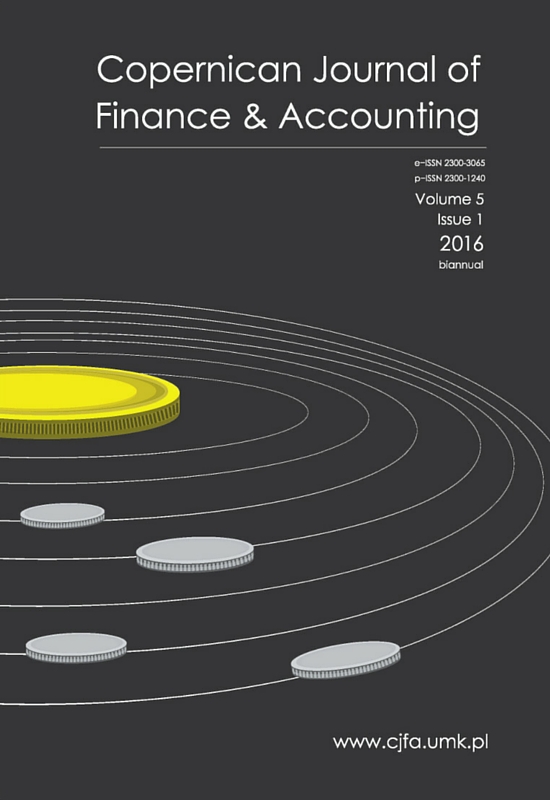An empirical evaluation of selected accounting-based value drivers in the Polish banking sector
DOI:
https://doi.org/10.12775/CJFA.2016.002Keywords
banks, financial reporting, market valueAbstract
The paper aims at empirical evaluation of selected accounting-based value drivers in the Polish banking sector. Using the analyses of correlation and regression, the study investigates the associations between banks’ charter values, proxied by Tobin’s Q, and a set of explanatory variables including size, operating efficiency, profitability, net cash flow generation capacity, leverage, asset liquidity, and risk management efficiency, each proxied by a measure based on the data available in the annual financial reports of banks. The examined sample covered all domestically-based banks listed on the Warsaw Stock Exchange over the period 1997–2014. The empirical evidence indicates a statistically significant positive impact of operating efficiency, profitability and risk management efficiency on charter values. In turn, the influence of size and leverage, although also positive, appears to be so weak, that it becomes irrelevant when combined with other explanatory variables. Additionally, no statistically significant impact was found for net cash flow generation capacity nor asset liquidity. The above findings suggest that equity investors in the Polish banking sector perceive performance and risk management efficiency as the key value drivers, practically neglecting the issues related to banks’ financial stability like the liquidity of assets or degree of leverage, thus presumably relying on the too-big-to-fail principle.References
Abuzayed, B., Molyneux, P., & Al-Fayoumi, N. (2009). Market value, book value and earnings: is bank efficiency a missing link?. Managerial Finance, 35 (2), 156-179. http:// dx.doi.org/10.1108/03074350910923491.
Ahmed, A.S., Takeda C., & Thomas, S. (1999). Bank loan loss provisions: A reexamination of capital management, earnings management and signaling effects. Journal of Accounting and Economics, 28 (1), 1–25. http://dx.doi.org/10.1016/S0165- 4101(99)00017-8.
Agostino, M., Drago, D., & Silipo, D.B. (2011). The value relevance of IFRS in the European banking industry. Review of Quantitative Finance and Accounting, 36 (3), 437- 457. http://dx.doi.org/10.1007/s11156-010-0184-1.
Allen, F., Carletti, E., & Marquez, R. (2011). Credit market competition and capital regulation. Review of Financial Studies, 24 (4), 983-1018. http://dx.doi.org/10.1093/ rfs/hhp089.
Anandarajan, A., Francis, B., Hasan, I., & John, K. (2011). Value relevance of banks: global evidence. Review of Quantitative Finance and Accounting, 36, 33-55. http://dx.doi. org/10.1007/s11156-010-0170-7.
Beaver, W.H., & Engel, E.E. (1996). Discretionary behavior with respect to allowances for loan losses and the behavior of security prices. Journal of Accounting and Economics, 22, 177–206. http://dx.doi.org/10.1016/S0165-4101(96)00428-4.
Bolibok, P. (2014). Application of the Ohlson model for testing the value relevance of accounting data in Polish banking sector. Zeszyty Naukowe Uniwersytetu Szczecińskiego, 802, Finanse, Rynki Finansowe, Ubezpieczenia, 65, 463-471.
Bolibok, P. (2015). Value relevance of impairment provisions in the Polish banking sector. Research Papers of Wroclaw University of Economics, 397, 58-67. http://dx.doi. org/10.15611/pn.2015.397.04.
Chiou, W.J. P., Porter, R. L., & Sopranzetti, B. J. (2014). Understanding the Channels of Bank Value Creation During Times of Crisis: Deconstructing ROA. Journal of Accounting and Finance, 14 (5), 11-23.
De Nicoló, G. (2000). Size, charter value and risk in banking: An international perspective. Board of Governors of the Federal Reserve System, 689, 1-42. http://dx.doi. org/10.2139/ssrn.255465.
Dimitropoulos, P.E., Asteriou, D., Koumanakos, E. (2010). The relevance of earnings and cash flows in a heavily regulated industry: Evidence from the Greek banking sector. Advances in Accounting, 26, 290–303. http://dx.doi.org/10.1016/j.adiac. 2010.08.005.
Fortin, R., Goldberg, G. M., Roth, G. (2011). Bank charter value determinants during the 2008 financial crisis. Journal of Finance and Accountancy, 1-13.
Gao, Z., Li, W., O’Hanlon, J. (2015). The informativeness of US banks’ statements of cash flows. Lancaster University Management School Working Paper, 1-53.
Gosh, S. (2009). Charter value and risk-taking: evidence from Indian banks. Journal of the Asia Pacific Economy, 14 (3), 270-286. http://dx.doi.org/10.1080/ 13547860902975606.
Hart, O., & Moore, J. (1995). Debt and seniority: An analysis of the role of hard claims in constraining management. American Economic Review, 85, 567-585.
http://bossa.pl/notowania/metastock/ (accessed: 15.09.2015).
http://site.securities.com/cgi-bin/comp_profiles/94dec/PL/comp_profiles.html (accessed: 15.09.2015).
Jordan, D. J., Rice, D., Sanchez, J., & Wort, D. (2011). Explaining bank market-to-book ratios: Evidence from 2006 to 2009. Journal of Banking and Finance, 35 (8), 2047- -2055. http://dx.doi.org/10.1016/j.jbankfin.2011.01.017
Lim, C.Y., Walker, M., & Lee, E. (2013). Are the loan loss and fair value components of bank income rationally priced? Research Collection School of Accountancy, Institutional Knowledge. Singapore Management University, 4, 1–51.
Mehran, H., & Thakor, A. (2011). Bank capital and value in the cross-section. The Review of Financial Studies, 24 (4), 1019-1067. http://dx.doi.org/10.1093/rfs/hhq022.
Miller, M. H. (1995). Do the M&M Propositions Apply to Banks? Journal of Banking and Finance, 19, 483–489. http://dx.doi.org/10.1016/0378-4266(94)00134-O.
Modigliani, F., & Miller, M. H. (1958). The cost of capital, corporate finance and the theory of investment. American Economic Review, 48, 261–297.
Ryan, S., Tucker, J., & Zarowin, P. (2006)., Classification and market pricing of the cash flows and accruals on trading positions. The Accounting Review, 81 (2), 443-472. http://dx.doi.org/10.2308/accr.2006.81.2.443.
Shamsuddin, A., & Xiang, D. (2012). Does bank efficiency matter? Market value relevance of bank efficiency in Australia. Applied Economics, 44, 3563-3572. http:// dx.doi.org/10.1080/00036846.2011.577027.
Wahlen, J. M. (1994). The nature of information in commercial bank loan loss disclosures, The Accounting Review, vol. 69, no. 3, pp. 455–478.
Wang, M. S. (2014). Financial innovation, Basel Accord III, and bank value. Emerging Markets Finance & Trade, 50 (2), 23-42. http://dx.doi.org/10.2753/REE1540- 496X5002S202.
Downloads
Published
How to Cite
Issue
Section
Stats
Number of views and downloads: 829
Number of citations: 0



